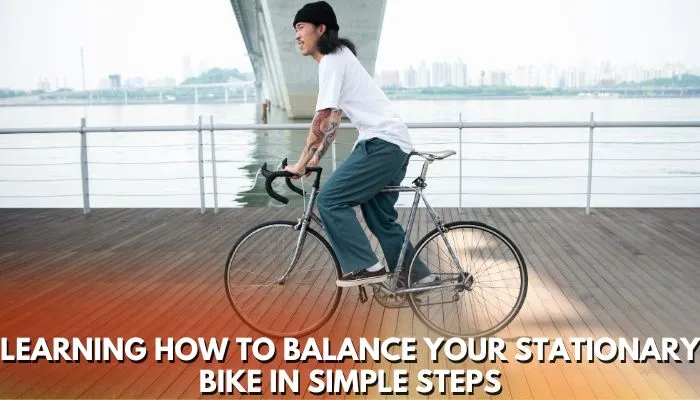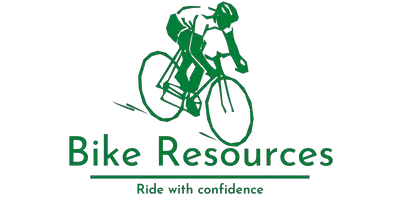Learning How To Balance Your Stationary Bike In Simple Steps

Imagine trying to ride a bike without riding or pedaling and then attempting to balance. You know you’re going to fall. This is due to the fact that a bike only has two points of interacting with the ground while it is immobile, which makes it unbalanced.
Table of Contents
Short Answer:
You must be thinking about how to balance on a bike without moving. Well, learning to strike a balance on a bike that is stationary, also known as track standing, is an advantageous capacity that will allow you to ride faster through traffic. You might discover how to achieve this with the appropriate attitude and consistent practice.
Childhood is associated with being able to ride a bike. The ability to balance on a bike can be learned by anyone—you don’t have to have been a kid to carry it out. The positive aspect is that learning how to ride properly can be done at any age, as well as the most important thing is that you won’t even need a tricycle that fits adults or your training tires.
In order to start riding on your stationary bikes perfectly, you will learn all the strategies and techniques you need to know in this article.
How to Balance On a Bike without Moving in 7 Steps
- Pick Your Bike
Mountain bikes are a better choice for practice while you’re beginning to master the technique because they include bigger tires and an upright structure. But don’t worry if you don’t have one; any road bike will do the trick.
- Search for a Wide Road
It will take considerable time and practice to learn track standing, much like when you first begin to learn how to ride a bike. You, therefore, need a place where you can move around freely without jeopardizing the safeguarding of others. Finding an upward road is beneficial because it will offer you the resistance required to bend your bike.
- Exercises for balance
Balance is essential for track standing. When riding a bike, you use your forward motion’s energy to aid in preserving your balance. It gets difficult to balance as you move more slowly since there is less velocity. At this stage, you have to depend on your perception of balance and the link to your body. You’ll likely need to give this step a few tries, given that it can be a little hard at first.
The rest, though, will be simple once you get used to it. Then, as you come to a stop, get off your bike and start riding again. Get up on the pedals and put one foot in front as you begin to slow down. In order to support yourself, it’s critical to grip the handlebar firmly.
Your feet serve as your starting point. Thus they are where your equilibrium begins. To maintain your position while accomplishing a point of stability, tightly press your feet down on the pedals. Avoid clenching your teeth too tightly to avoid compromising your balance.
It’s crucial to maintain a balanced body weight. It would be best if you also continued to look ahead. Although you may be drawn in, try to avoid the desire to stare at the ground because doing so could make it challenging for you to stay straight. If you feel the need to look, keep your head going forward and slant your gaze downward.
- Turn the Wheel
As soon as you come to a halt, lightly press the brakes, and then slowly turn the wheel in the direction of your lead foot, which is the one on the top pedal. To find equilibrium, you should now slowly rotate your handlebar to the left and right. However, don’t entirely adjust the path of your wheel because this will toss off your balance. As a result, maintain your wheel’s direction of rotation (if it is facing left) and make minor movements.
- The Switch Foot Technique
Maintain small flexibility in your legs as you stand. For appropriate balance, it’s also crucial to maintain an uninterrupted position with your feet on the pedal.
Because of this, you ought to avoid standing on your toes. To prevent the bike from dropping, start making moderate movements with it. To move the bike a little forward, depress the leading foot and lift your back foot as if you were about to start riding.
Next, reverse the motion by pulling up the lead foot while pushing down the back foot. By doing this, you can get back to where you were with the pedals.
Keep your balance by shifting back and forth between those two motions (unweighting and pressing your weight down). Start moving as soon as you’re ready, then take a moment and perform the whole workout again.
- Move as little as possible.
It’s time to stand stiller while pedaling forward and backward with your feet now that you know how to do it. You won’t be motionless because of this; rather, you’ll move fewer times to maintain your balance. Try to maintain your composure during this process because the more calm you are, the more still your body will be.
Apply little pressure to the front foot, whichever one it may be, and focus on keeping your body balanced over the bottom bracket of your bike.
Ensure that you apply more pressure to the pedal if you begin to lean to the left. Reduce the pressure on the pedal if you start to slide to the right. Continue to practice until you get the ideal equilibrium with the least amount of movement.
- Initially, practice, and then practice some more
Track standing will require a little while to learn, just like any new ability. Do not give up if you fall at first (because you will). Both you and the professionals you see started somewhere. Track standing drills should last five seconds or less per trial. As your confidence grows, increase the amount of time. You’ll get the hang of it sooner than you think.
Is it easy to balance on a bike without moving?
Balancing on a bike without moving can be challenging for some people, especially beginners who are still learning how to ride a bike. However, with some practice, most people can learn to balance on a stationary bike relatively easily.
The key to balancing on a stationary bike is to find your center of balance and maintain it. This involves shifting your weight slightly forward and backward until you find the sweet spot where you can balance without wobbling.
Once you’ve found your balance, the key is to stay relaxed and keep your upper body stable, which will help you maintain your balance.
While balancing on a stationary bike is easier than balancing on a moving bike, it still requires some physical coordination and mental focus. It may take some time and practice to get the hang of it, but with patience and persistence, most people can learn to balance on a stationary bike without too much difficulty.
Is It Important To Balance A Bike Without Moving?

Learning to balance on a bike without moving is an important first step in learning to ride a bike because it helps you develop a sense of balance and control over the bike.
When you first start, riding a bike can be intimidating, and it can be difficult to get a feel for how to balance on two wheels. By practicing balancing on a stationary bike, you can begin to develop the muscle memory and coordination needed to maintain your balance while in motion.
Additionally, learning to balance on a stationary bike can help you build your confidence and reduce your fear of falling. Falling is a common concern for many people when learning to ride a bike.
Still, by practicing balancing first, you can become more comfortable with the bike and build your confidence in your ability to control it. Overall, learning to balance on a bike without moving is an important foundational skill that can help you become a more confident and skilled bike rider.
Some Tips For Balancing On A Bike:
Balancing on a bike is a fundamental skill that every biker must master in order to ride confidently and safely. While it may seem daunting at first, with practice and a few key tips, you can learn to balance on a bike like a pro. Here are some tips to help you improve your balance on a bike:
- Start Slowly:
If you’re new to cycling or haven’t been on a bike for a while, start by riding at a slow pace. This will help you get comfortable with the bike and adjust to the feeling of balancing on two wheels.
- Use Your Core Muscles:
Your core muscles are critical for maintaining balance on a bike. Engage your core muscles by sitting up straight and tightening your abdominal muscles. This will help you stay stable while riding.
- Look Ahead:
Keep your eyes focused on the road ahead rather than staring at your front wheel. By looking ahead, you can anticipate any obstacles or changes in the road and adjust your balance accordingly.
- Keep Your Hands Loose:
Tightly gripping the handlebars can make it harder to balance on a bike. Instead, keep your hands loose and relaxed, with your fingers lightly gripping the handlebars.
- Practice Balancing Exercises:
There are several exercises you can do to improve your balance on a bike. One simple exercise is to practice balancing while standing still. Start by standing with your feet shoulder-width apart, then lift one foot off the ground and try to balance on the other. Once you’ve mastered this, try doing the same exercise while standing on your bike pedals.
- Use Your Body Weight to Steer:
When turning, use your body weight to lean into the turn rather than turning the handlebars. This will help you maintain your balance and control your bike more effectively.
- Keep Your Pedals Level:
When riding, try to keep your pedals level with each other. This will help you maintain a smooth and stable pedal stroke, which can improve your overall balance.
- Practice, Practice, Practice:
The key to mastering balance on a bike is practice. The more you ride, the more comfortable you will become with the feeling of balancing on two wheels.
By following these tips and practicing regularly, you can improve your balance on a bike and ride with confidence and ease.
Remember to start slowly, engage your core muscles, look ahead, keep your hands loose, practice balancing exercises, use your body weight to steer, keep your pedals level, and most importantly, have fun!
FAQs:
Why is riding a bike while it’s still so challenging to balance?
The conservation of angular momentum is the main reason for this. When a bike is moving, its tires rotated. Each rotating tire produces angular momentum that is not equal to zero.
Is balancing a bike possible?
At first glance, you could assume the rider maintains a bike’s balance. In the end, this is only partially accurate. Modern bikes can be started properly and balanced perfectly, continuing on the path as if any person were controlling them.
Conclusion:
Balancing on a stationary bike is similar to balancing on a moving bike, except you don’t have the forward momentum to help you stay upright. Here we mentioned 7 simple steps to balance on a stationary bike. Now everyone knows how to balance on a bike without moving.
Anyone can achieve this skill in just a matter of a day, and then you will be good to go. Remember, balancing on a stationary bike takes practice, so don’t get discouraged if you can’t do it immediately. With time and practice, you can balance for longer periods.

From e-bikes for those looking for an extra boost on their commutes to tricycles and balance bikes perfect for introducing kids to the joys of cycling, we aim to have something for everyone. Our road, hybrid, and mountain bikes are designed to meet the needs of riders with various interests and skill levels.
If you have any specific questions about our bicycle lineup or if there’s anything else you’d like to know, please don’t hesitate to ask. We’re here to assist you in finding the perfect bike to suit your needs.
Happy cycling! ?♂️?♀️